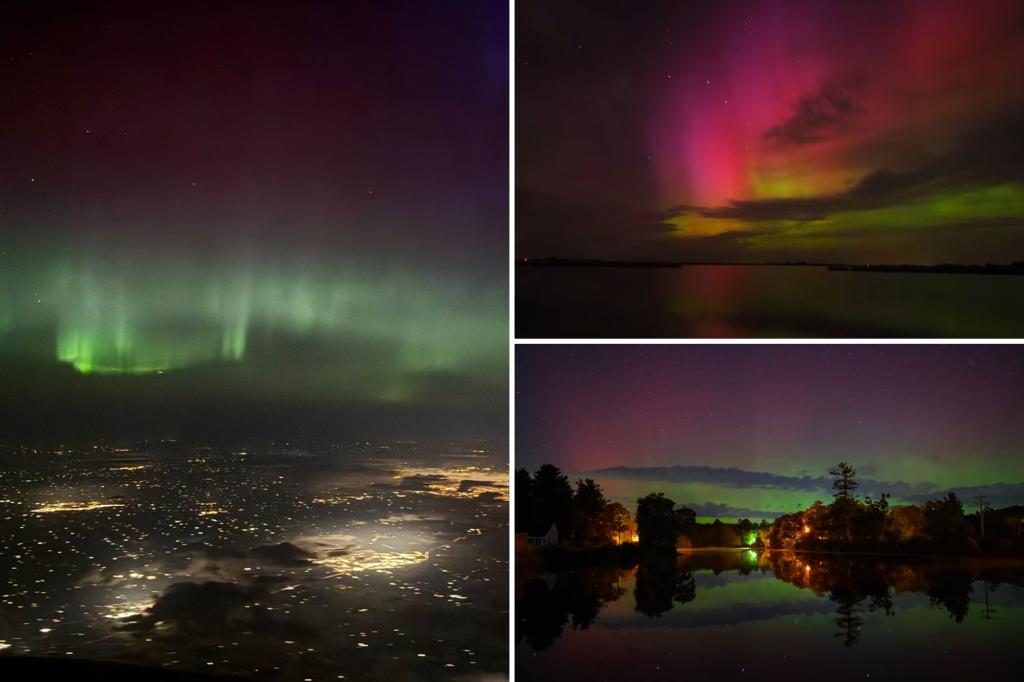Cosmic Light Show: Sunday’s Spectacular Northern Lights Display
The night sky transformed into a mesmerizing canvas of dancing colors late Sunday into Monday as a powerful geomagnetic storm pushed the Northern Lights far south of their typical viewing range. What began as a routine solar event developed into a breathtaking astronomical spectacle that captivated skygazers across the northern United States, with vibrant displays visible in places rarely treated to such cosmic performances. From Michigan to New Hampshire and across to the Pacific Northwest, people stepped outside to witness sheets of green and purple light rippling across the night sky, a reminder of the powerful connection between our star and planet Earth.
The celestial show began when NOAA’s Space Weather Prediction Center identified a coronal hole on the Sun’s surface and issued a Geomagnetic Storm Warning. These dark areas on our star allow solar wind to escape more readily into space, sending charged particles racing toward Earth at tremendous speeds. When these particles arrived at our planet, they interacted with Earth’s magnetic field, triggering a level 3 (out of 5) geomagnetic storm. This interaction, invisible to the naked eye but measured by scientific instruments, created the perfect conditions for an unusually widespread aurora display. The storm’s intensity peaked early Monday when the KP index—the 9-point scale scientists use to measure geomagnetic activity—reached an impressive 6.67, energizing the particles in our upper atmosphere to produce vivid auroras much farther south than normal.
Across the northern tier of the United States, people were treated to nature’s own light show as the aurora borealis painted the sky with ethereal colors. In Alton, New Hampshire, time-lapse footage captured nearly an hour of pulsating lights transforming the normally dark rural sky into a luminous spectacle. Michigan’s Isle Royale National Park, already famous for its pristine wilderness and isolation, became an ideal viewing spot as bright green curtains of light reflected off Lake Superior, doubling the visual impact against the park’s dark skies. Even urban areas that typically suffer from light pollution weren’t completely left out, as the unusually strong storm allowed the aurora to shine through despite competing artificial light sources in some locations.
The aurora’s unusual southern reach created once-in-a-lifetime viewing opportunities for many Americans who would typically need to travel to Alaska, Canada, or Scandinavian countries to witness such displays. Social media quickly filled with stunning images and videos as people shared their experiences of this rare event. Perhaps one of the most enviable viewing spots belonged to lucky air travelers on a flight from New York to San Francisco Sunday evening. Passenger Keagan Wernicke captured extraordinary images of the Northern Lights from 30,000 feet above, later sharing the photos with a simple piece of advice that resonated with many: “Always look out of airplane windows.” Without the atmospheric distortion and light pollution that ground observers contend with, airline passengers at the right place and right time enjoyed an unobstructed, front-row seat to one of nature’s most spectacular phenomena.
The visibility of the Northern Lights extended to the Pacific Northwest as well, where Seattle-area observers were treated to the uncommon sight. Skunkbay Weather, which monitors atmospheric conditions in the region, recorded the green glow as it appeared over Puget Sound. This wide geographic spread of aurora sightings—from the Northeast through the Great Lakes region and across to the Northwest—demonstrates the exceptional strength of this particular geomagnetic storm. While urban residents often missed the more subtle colors due to light pollution, those who made the effort to reach darker locations outside city limits were rewarded with views of shimmering curtains of light that seemed to dance across the northern horizon, occasionally expanding overhead during the storm’s most intense periods.
Though the Space Weather Prediction Center indicated that additional aurora activity might continue into Monday night, forecasters cautioned that subsequent displays would likely be less dramatic than Sunday’s peak showing. This particular storm serves as a reminder that we’re approaching the solar maximum—the period in the Sun’s 11-year cycle when solar activity reaches its highest levels. During this phase, which is expected to peak in 2024-2025, coronal holes, solar flares, and coronal mass ejections become more frequent, potentially triggering more geomagnetic storms and aurora displays. For skygazers who missed this event, the coming months may offer additional opportunities to witness the Northern Lights at unusually southern latitudes, though timing and clear skies remain crucial factors for successful viewing. Each aurora display is unique, shaped by the specific solar conditions that created it and the atmospheric conditions through which we observe it—making Sunday’s widespread event a memorable chapter in this solar cycle’s unfolding story.


